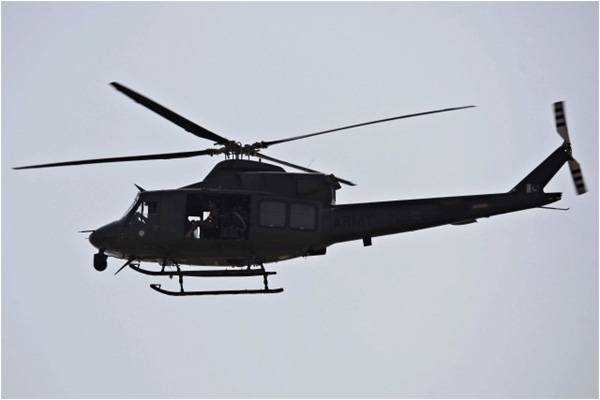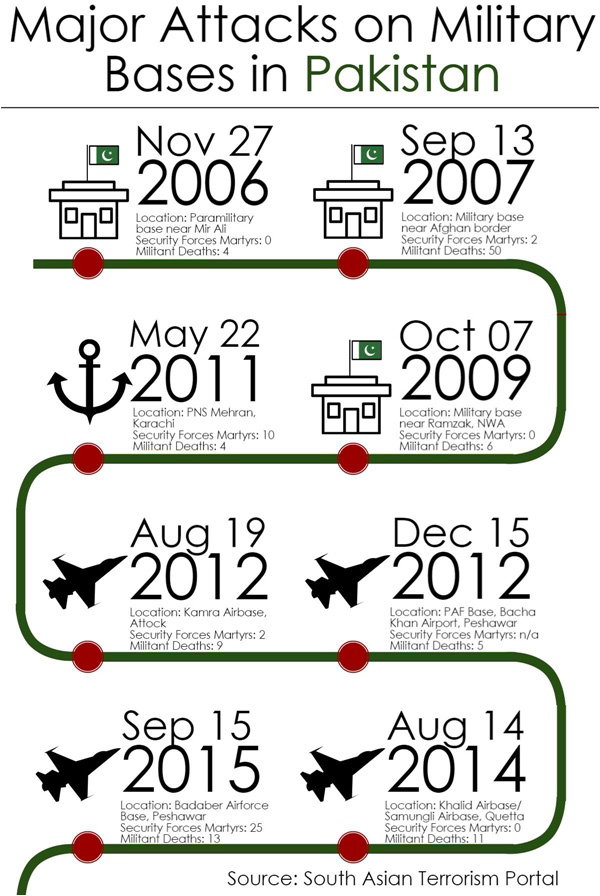
On September 18, the Tehrik-e-Taliban Pakistan (TTP) carried out yet another brazen attack on military infrastructure in Pakistan. In the early hours of the day, the Badaber Air Force Base in Peshawar was breached by an armed group of terrorists at two points. The military’s Quick Response Force (QRF) engaged the assailants, who had split into sub-groups. A major was shot in the leg during the crossfire, and a captain was one of the 29 killed in the ensuing gunfight. This was one of the biggest attacks on a military base in recent times, and resulted in the largest number of friendly casualties.
Whether this attack was successful or foiled depends on perspective. The Inter-Services Public Relations calls it a foiled attempt. Reports indicate a siege plan – the terrorists were well-armed, well-trained, carried explosives and grenades and had rations for several days. This is a common trait with the larger, more organized attacks. The perpetrators of the attack on the Army Public School in Peshawar Cantonment also brought several days of rations with them. “None of them [were] wearing suicide vests. They were not suicide bombers. They had come to fight a long battle and fight till the last bullet,” said an official.
The QRF engaged and contained the 13 militants, but one group managed to reach the nearby mosque and kill 16 worshippers mid-prayer. The police formed a cordon outside the base to cut off a potential escape. Lt Gen Bajwa, the recently promoted head of the ISPR, said three helicopters were utilized in clearance and evacuation of casualties.

The argument made here is that this could have been a much bigger tragedy if they had managed to go deeper into the base, or worse, entrenched themselves for a protracted engagement. The attack was foiled because the assailants were killed swiftly and denied entry into the more sensitive areas of the base. In the process, 25 valiant soldiers sacrificed their lives for their country.
The attack was planned and controlled from Afghanistan, and the attackers crossed the border to carry out the attack, the ISPR said. A week later, Adviser to the Prime Minister on National Security and Foreign Affairs Sartaj Aziz said that Afghanistan would be provided with evidence of the attack originating on its soil.
The other side of the argument is that as long as the attackers manage to cause even a single casualty, their plan is a success. The ISPR says all attackers wore uniforms of the Frontier Constabulary – a tried-and-tested tactic that the TTP has used in a number of high-profile attacks to gain access and to create confusion during the attack. In this attack, the same tactic once again allowed them to arrive at the gates of the PAF base undetected, where the fighting began.
TTP’s Darra Adamkhel leader Khalifa Omar Mansoor released a video of 16 militants as they departed for the attack. For those keeping count, three militants thus remain unaccounted for. Further, it can be said that the terrorists were successful in shaming Pakistan internationally, and giving credence to the claim that despite Pakistan’s efforts, they are alive and well, albeit across the border.
On social media, the military was simultaneously hailed as heroes, and lambasted. Part of the reason is the near shocking neck-and-neck competition between the ISPR and the Taliban spokesman Muhammad Khurassani to shape the narrative of the attack in real time. The banned TTP sent out a steady stream of updates to several journalists, clearly one-sided, but in real time, raising questions about how they were able to communicate with the attackers and then relay this information to the world. This side of the argument faults the military for being unable to stop the attack in the first place.
Air Vice Marshal (r) Shahzad Chaudhry feels both arguments are legitimate, but things cannot be seen in black or white. “It just depends on how you look at it,” he says. “They could have done much more harm if they had penetrated deeper. But then again, if they were able to breach the perimeter and maim or kill even one, they are meeting their objectives. This is a war, and every war has casualties.”
The argument that the military failed to prevent this from happening seems plausible and convenient at the outset. But in reality, the blame for the attack is collective. Pakistan has been at a state of war for well over a decade now. The horrendous attack on schoolchildren in Peshawar in December 2014 may have jolted a bereaved nation into (re)action, but stagnation and combat fatigue set in quickly. If the military is to be faulted for being unable to stop 13 assailants as they traveled undetected to the PAF’s front door, surely the politicians and administration must also share the responsibility. The police, primarily responsible for citizens’ well-being and preventing criminals from roaming freely, come under the administration. The fact that they travelled 60 kilometers from the border indicates they had facilitators on Pakistani soil. Foot intelligence and citizen vigilance are critical tools for counter-terrorism that could uncover these wolves in sheep’s skin. That role has to be played by the general public.
“This is a clash of civilizations, not militaries,” says AVM Chaudhry. “We have to collectively accept the fact that we are at war with these individuals, and we have to collectively take the necessary steps to play our individual parts. Unfortunately, we do nothing to help pitch in as a society.”
The author is a journalist and a Senior Research Fellow at the Center for Research and Security Studies, Islamabad. He has a Master’s degree in strategic communications from Ithaca College, NY.
Email: zeeshan[dot]salahuddin[at]gmail.com
Twitter: @zeesalahuddin
Whether this attack was successful or foiled depends on perspective. The Inter-Services Public Relations calls it a foiled attempt. Reports indicate a siege plan – the terrorists were well-armed, well-trained, carried explosives and grenades and had rations for several days. This is a common trait with the larger, more organized attacks. The perpetrators of the attack on the Army Public School in Peshawar Cantonment also brought several days of rations with them. “None of them [were] wearing suicide vests. They were not suicide bombers. They had come to fight a long battle and fight till the last bullet,” said an official.
The QRF engaged and contained the 13 militants, but one group managed to reach the nearby mosque and kill 16 worshippers mid-prayer. The police formed a cordon outside the base to cut off a potential escape. Lt Gen Bajwa, the recently promoted head of the ISPR, said three helicopters were utilized in clearance and evacuation of casualties.

The argument made here is that this could have been a much bigger tragedy if they had managed to go deeper into the base, or worse, entrenched themselves for a protracted engagement. The attack was foiled because the assailants were killed swiftly and denied entry into the more sensitive areas of the base. In the process, 25 valiant soldiers sacrificed their lives for their country.
The attack was planned and controlled from Afghanistan, and the attackers crossed the border to carry out the attack, the ISPR said. A week later, Adviser to the Prime Minister on National Security and Foreign Affairs Sartaj Aziz said that Afghanistan would be provided with evidence of the attack originating on its soil.
The other side of the argument is that as long as the attackers manage to cause even a single casualty, their plan is a success. The ISPR says all attackers wore uniforms of the Frontier Constabulary – a tried-and-tested tactic that the TTP has used in a number of high-profile attacks to gain access and to create confusion during the attack. In this attack, the same tactic once again allowed them to arrive at the gates of the PAF base undetected, where the fighting began.
TTP’s Darra Adamkhel leader Khalifa Omar Mansoor released a video of 16 militants as they departed for the attack. For those keeping count, three militants thus remain unaccounted for. Further, it can be said that the terrorists were successful in shaming Pakistan internationally, and giving credence to the claim that despite Pakistan’s efforts, they are alive and well, albeit across the border.
On social media, the military was simultaneously hailed as heroes, and lambasted. Part of the reason is the near shocking neck-and-neck competition between the ISPR and the Taliban spokesman Muhammad Khurassani to shape the narrative of the attack in real time. The banned TTP sent out a steady stream of updates to several journalists, clearly one-sided, but in real time, raising questions about how they were able to communicate with the attackers and then relay this information to the world. This side of the argument faults the military for being unable to stop the attack in the first place.
Air Vice Marshal (r) Shahzad Chaudhry feels both arguments are legitimate, but things cannot be seen in black or white. “It just depends on how you look at it,” he says. “They could have done much more harm if they had penetrated deeper. But then again, if they were able to breach the perimeter and maim or kill even one, they are meeting their objectives. This is a war, and every war has casualties.”
The argument that the military failed to prevent this from happening seems plausible and convenient at the outset. But in reality, the blame for the attack is collective. Pakistan has been at a state of war for well over a decade now. The horrendous attack on schoolchildren in Peshawar in December 2014 may have jolted a bereaved nation into (re)action, but stagnation and combat fatigue set in quickly. If the military is to be faulted for being unable to stop 13 assailants as they traveled undetected to the PAF’s front door, surely the politicians and administration must also share the responsibility. The police, primarily responsible for citizens’ well-being and preventing criminals from roaming freely, come under the administration. The fact that they travelled 60 kilometers from the border indicates they had facilitators on Pakistani soil. Foot intelligence and citizen vigilance are critical tools for counter-terrorism that could uncover these wolves in sheep’s skin. That role has to be played by the general public.
“This is a clash of civilizations, not militaries,” says AVM Chaudhry. “We have to collectively accept the fact that we are at war with these individuals, and we have to collectively take the necessary steps to play our individual parts. Unfortunately, we do nothing to help pitch in as a society.”
The author is a journalist and a Senior Research Fellow at the Center for Research and Security Studies, Islamabad. He has a Master’s degree in strategic communications from Ithaca College, NY.
Email: zeeshan[dot]salahuddin[at]gmail.com
Twitter: @zeesalahuddin

